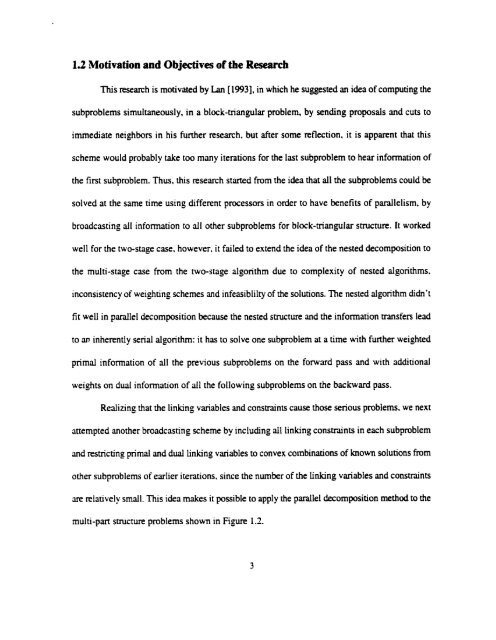X - UWSpace - University of Waterloo
X - UWSpace - University of Waterloo
X - UWSpace - University of Waterloo
You also want an ePaper? Increase the reach of your titles
YUMPU automatically turns print PDFs into web optimized ePapers that Google loves.
1.2 Motivation and Objectives <strong>of</strong> the Researcb<br />
This research is motivated by Lan [1993], in which he suggested an idea <strong>of</strong> computing the<br />
subproblems simultaneously, in a bla'k-triangular problem. by sending proposais and cuts to<br />
immediate neighbors in his funher research. but after some reflection. it is apparent that this<br />
scheme would probably take too many iterations for the last subproblem to hear information <strong>of</strong><br />
the fint subproblem. Thus, this research stmed h m the ider that all the subproblems could be<br />
solved at the sme time using different processors in order to have benefits <strong>of</strong> parallelism. by<br />
broadclisting dl information to ail other subprob lems for block-niangular stnicture.. It worked<br />
well for the two-stage case. however. it failed to extend the idea <strong>of</strong> the nested decornposition to<br />
the multi-stage case from the two-stage alsorithm due to complexity <strong>of</strong> nested algorithms.<br />
inconsistency <strong>of</strong> weighting schemes and infeasiblilty <strong>of</strong> the solutions. The nested aigorithm didn't<br />
fit well in paralle1 decomposition because the nested stnicture and the information aansfea lead<br />
to m inherently seriai alprithm: it has to solve one subproblem at a time with further weighted<br />
primal information <strong>of</strong> dl the previous subproblems on the forward ppass and with additional<br />
weights on dual information <strong>of</strong> dl the following subproblems on the backward p as<br />
Redizing that the linking variables and constnints cause those serious problems. we next<br />
attempted another bruadcasting scheme by inciuding al1 linking constraints in each subpmblem<br />
and restricting primal and dual linking variables to convex combinations <strong>of</strong> hown solutions from<br />
other subproblerns <strong>of</strong> emlier iterations. since the nurnber <strong>of</strong> the linking variables and constraints<br />
îce relatively smail. This ides makes it possible to apply the parallel decomposition method to the<br />
multi-pan structure problems shown in Fi-rn 1.2.
















